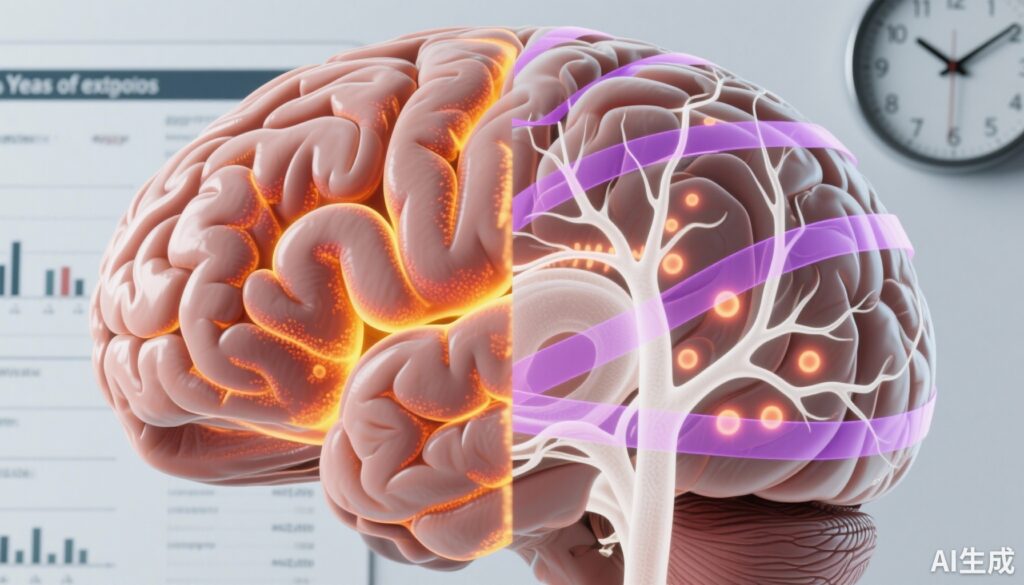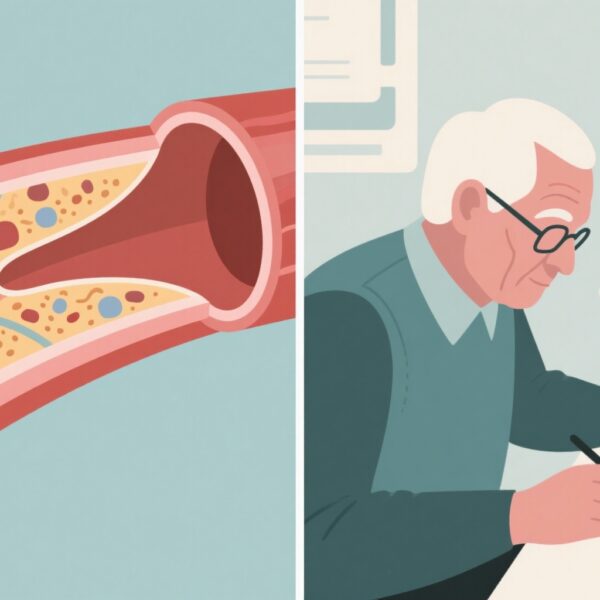Highlights
– Longer chronicity (years above biomarker thresholds) of amyloid and white matter hyperintensities (WMHs) associates with accelerated clinical decline.
– WMH burden and amyloid interact synergistically: vascular white matter injury amplifies amyloid-related worsening in Clinical Dementia Rating–Sum of Boxes (CDR-SB).
– Tau accumulation (measured with MK-6240 PET) significantly mediates the relationship between combined amyloid/vascular burden and cognitive decline.
Background
Alzheimer’s disease (AD) and age-related vascular brain injury frequently co-exist and together shape the trajectory of cognitive decline. Amyloid-beta (Aβ) accumulation, tau neurofibrillary tangles, and cerebrovascular changes such as white matter hyperintensities (WMHs) represent overlapping pathological processes that evolve over decades. Understanding how the duration and interaction of these pathologies influence clinical progression remains essential to inform prognosis and to time interventions that may slow or prevent symptomatic disease.
Study design
Du and colleagues examined how the timing and duration of amyloid and vascular burden relate to clinical symptom trajectories, and whether tau acts as a mediator in these relationships (Du et al., 2025). The analysis used a cohort approach with multimodal imaging and longitudinal clinical assessments.
Key elements of the design:
- Participants: 558 individuals with baseline [C-11] Pittsburgh compound B (PiB) PET for amyloid, MRI-derived WMH quantification, and longitudinal Clinical Dementia Rating–Sum of Boxes (CDR-SB) assessments. A subset of 500 participants also underwent MK-6240 tau PET imaging.
- Primary outcome: CDR-SB trajectories over follow-up, as a clinically oriented measure of global dementia severity and progression.
- Exposure variables: Two operationalizations of pathology burden—(1) chronicity, defined as years above established biomarker-positivity thresholds for amyloid (A+ years) and WMHs (V+ years); and (2) estimated levels of amyloid and WMH at each CDR visit to model time-varying burden.
- Analytic approach: Longitudinal mixed-effects models for CDR-SB trajectories, testing main effects and interactions between amyloid and WMH burden; moderated mediation models to assess whether tau burden mediates the combined effect of amyloid and vascular pathology on clinical outcomes.
Key findings
1) Chronicity clarifies exposure timing and predicts decline
The authors introduce chronicity—years since biomarker-defined positivity—as a person-level summary of exposure duration. Whether pathology burden was represented by chronicity (A+ years, V+ years) or by estimated levels at clinical visits, longer duration above positivity thresholds for either amyloid or WMH was associated with accelerated CDR-SB trajectories. In practical terms, individuals who had been A+ or V+ for a longer period experienced faster progression of clinical symptoms than those with shorter durations.
2) Synergistic interaction between amyloid and WMH
Across modeling strategies, significant interactions were observed between amyloid burden and WMH burden: WMH accumulation exacerbated amyloid-related clinical decline. The effect was not merely additive; rather, individuals with both greater amyloid and greater WMH burden showed steeper CDR-SB increases than expected from each pathology alone. Importantly, progression from early to mild dementia stages was particularly sensitive to higher WMH chronicity even when controlling for the duration of amyloid positivity.
3) Tau mediates the impact of combined A and V burden
In the subset with MK-6240 tau PET, tau was a significant mediator of the relationship between combined amyloid and vascular burden and clinical decline. In a moderated mediation framework, the authors demonstrated that amyloid and WMH interact upstream, contributing to downstream tau accumulation, which in turn links to accelerated impairment captured by the CDR-SB. This supports the model in which vascular injury heightens the clinical expression of amyloid pathology through facilitation of tau spread or accumulation.
4) Clinical and conceptual implications
– Measuring chronicity provides clinicians and researchers with an interpretable index of how long a patient has been exposed to pathological burdens, beyond cross-sectional burden measures. This enhances prognostic precision for expected clinical trajectories.
– The synergistic effect of WMH and amyloid suggests that cerebrovascular disease is not an incidental comorbidity but a modifier of amyloid-related clinical progression; hence, vascular health represents a potentially modifiable lever to slow symptom onset and progression.
Expert commentary and mechanistic considerations
Strengthening biological plausibility, this work aligns with conceptual frameworks in which amyloid accumulation is an early, slowly evolving process that predisposes the brain to tau propagation, and where vascular injury—manifested as WMHs—can lower the threshold for clinical expression by damaging white matter networks, impairing clearance mechanisms, and promoting neuroinflammation. Tau’s mediating role observed here is consistent with the emerging consensus that tau pathology correlates more tightly with clinical decline than amyloid burden alone.
From a translational standpoint, the findings argue for more nuanced participant stratification in clinical trials: accounting for vascular burden and chronicity of amyloid may reduce outcome heterogeneity and identify subgroups most likely to benefit from anti-amyloid, anti-tau, or vascular-targeted interventions. Likewise, clinical care strategies emphasizing aggressive vascular risk factor management could be prioritized in A+ individuals to potentially delay or attenuate progression.
Strengths
– Multimodal imaging with amyloid PET, MRI WMH quantification, and second-generation tau PET (MK-6240) enables a comprehensive view of interacting pathologies.
– Use of longitudinal clinical outcomes (CDR-SB) aligns findings with clinically meaningful progression stages rather than only cognitive test scores.
– Introduction and operationalization of chronicity provide a conceptually clear and person-centered measure that captures timing of exposure—critical for diseases that unfold over decades.
Limitations and generalizability
– Observational cohort: Causal inferences remain limited despite mediation modeling; unmeasured confounding and reverse causation risk persist.
– Cohort characteristics and selection: Imaging-intensive cohorts tend to include participants who are healthier, more educated, and less diverse than the general population. Generalizability to broader and more racially/ethnically diverse populations needs confirmation.
– Threshold definitions: Positivity thresholds for amyloid and WMH, while necessary for chronicity estimation, are partly operational and may vary across assays and imaging platforms.
– Timing resolution: Chronicity estimates depend on available scans and the modeling approach; precise dating of biomarker conversion requires frequent imaging and may be less precise in routine clinical contexts.
Clinical implications and practice considerations
1) Risk stratification and counseling: Estimating chronicity can help clinicians provide patients with a clearer prognosis by integrating both how long a pathology has been present and its current burden. This may guide decisions about monitoring frequency and eligibility for trials.
2) Vascular risk modification: The demonstrated synergy between WMH and amyloid supports prioritizing vascular risk factor control (blood pressure, diabetes, lipid management, smoking cessation, physical activity) particularly in A+ individuals as a potentially impactful and widely available intervention.
3) Biomarker-guided trials: Trials of anti-amyloid or anti-tau agents should consider enrolling or stratifying participants by vascular burden and chronicity to reduce heterogeneity and test whether combined therapeutic approaches (amyloid/tau reduction plus vascular risk modification) yield additive benefit.
4) Tau imaging and staging: Longitudinal tau PET could refine staging and timing of interventions. Since tau appears to be the proximate mediator of decline, anti-tau strategies may hold particular promise once tau spread is detected or predicted.
Research and policy priorities
– Validate chronicity metrics across diverse cohorts and harmonize biomarker positivity thresholds to enable comparability across studies and clinical settings.
– Conduct longitudinal studies with repeated tau imaging to track the dynamics by which amyloid and vascular injury precipitate tau accumulation and spread.
– Design interventional trials that combine vascular risk management with disease-modifying therapies for amyloid and/or tau, with pre-specified subgroup analyses by chronicity and WMH burden.
– Expand recruitment of underrepresented populations to determine whether the observed interactions and mediation pathways hold across varied sociodemographic and genetic backgrounds.
Conclusion
Du et al. provide compelling evidence that the duration and interaction of amyloid and vascular pathology shape clinical trajectories, and that tau accumulation mediates these effects. Using chronicity as an exposure metric enhances clinical interpretability and prognostic precision. From a therapeutic perspective, these findings reinforce the importance of vascular health as a modifier of neurodegenerative processes and point to tau as a central downstream target linking combined pathology to symptom progression. Integrating vascular risk management with biomarker-driven therapeutic strategies and advancing longitudinal tau imaging are logical next steps.
Funding and trial registration
For funding and clinicaltrials.gov information, refer to the original publication: Du L, Langhough RE, Hermann BP, et al. Tau mediates the impact of amyloid and vascular disease burden on the trajectory of clinical symptoms. Alzheimers Dement. 2025 Oct;21(10):e70831. doi: 10.1002/alz.70831. PMID: 41164853; PMCID: PMC12572831.
References
Du L, Langhough RE, Hermann BP, Jonaitis EM, Betthauser TJ, Rivera-Rivera LA, Cody KA, Chin NA, Cadman RV, Johnson KM, Field AS, Asthana S, Eisenmenger L, Christian BT, Johnson SC. Tau mediates the impact of amyloid and vascular disease burden on the trajectory of clinical symptoms. Alzheimers Dement. 2025 Oct;21(10):e70831. doi: 10.1002/alz.70831. PMID: 41164853; PMCID: PMC12572831.
AI image prompt for article thumbnail
High-resolution clinical composite: frontal view of a human brain split down the midline. Left hemisphere visualized as a PET amyloid map with warm colors (red/orange) indicating amyloid deposition; right hemisphere shows MRI white matter hyperintensities as bright, patchy spots on a T2/FLAIR-like texture. A translucent purple tau PET ribbon overlays midline areas to represent tau accumulation. Subtle background elements include a faded clinical chart with rising CDR-SB scores and a small clock to signify ‘years of exposure’. Scientific, realistic, neutral clinical color palette, high detail, suitable for a medical journal cover.



